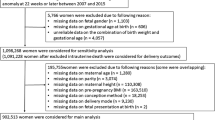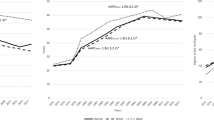Abstract
Objective
To study the impact of fetal gender on the risk of spontaneous preterm birth in various ethnicities.
Study design
National cohort study in which all singleton live births from 25+0 weeks onwards without congenital anomalies were included of African, Asian, and Mediterranean women (1999–2010). Our primary outcome measure was preterm birth before 37 weeks. Per ethnic group, male and female neonates were compared.
Result
In each ethnic group, male fetuses were at increased risk of preterm birth (adjusted odds ratio (aOR) 1.63 for African, aOR 1.71 for Asian, and aOR 1.84 for Mediterranean males). The population-attributable risk of male gender on spontaneous preterm birth is lower in African women (3.9%) than in Asian (10.3%) and Mediterranean women (9.0%).
Conclusion
Male fetal gender is associated with spontaneous preterm birth in African, Asian, and Mediterranean women, but the total impact of ethnicity on spontaneous preterm birth rate is different.
This is a preview of subscription content, access via your institution
Access options
Subscribe to this journal
Receive 12 print issues and online access
$259.00 per year
only $21.58 per issue
Buy this article
- Purchase on Springer Link
- Instant access to full article PDF
Prices may be subject to local taxes which are calculated during checkout
Similar content being viewed by others
References
Blencowe H, Cousens S, Oestergaard MZ, Chou D, Moller AB, Narwal R, et al. National, regional, and worldwide estimates of preterm birth rates in the year 2010 with time trends since 1990 for selected countries: a systematic analysis and implications. Lancet. 2012;379:2162–72.
March of Dimes, PMNCH, Save the Children, WHO. Born too soon: the global action report on preterm birth. Geneva: March of Dimes, PMNCH, Save the Children, WHO; 2012.
Saigal S, Doyle LW. An overview of mortality and sequelae of preterm birth from infancy to adulthood. Lancet. 2008;371:261–9.
Goldenberg RL, Culhane JF, Iams JD, Romero R. Epidemiology and causes of preterm birth. Lancet. 2008;371:75–84.
Romero R, Espinoza J, Kusanovic JP, Gotsch F, Hassan S, Erez O, et al. The preterm parturition syndrome. BJOG. 2006;113:17–42.
Schaaf JM, Liem SM, Mol BW, Abu-Hanna A, Ravelli AC. Ethnic and racial disparities in the risk of preterm birth: a systematic review and meta-analysis. Am J Perinatol. 2013;30:433–50.
Schaaf JM, Mol BW, Abu-Hanna A, Ravelli AC. Ethnic disparities in the risk of adverse neonatal outcome after spontaneous preterm birth. Acta Obstet Gynecol Scand. 2012;91:1402–8.
Cooperstock M, Campbell J. Excess males in preterm birth: interactions with gestational age, race, and multiple birth. Obstet Gynecol. 1996;88:189–93.
Zeitlin J, Saurel-Cubizolles MJ, De Mouzon MJ, Rivera L, Ancel PY, Blondel B, et al. Fetal sex and preterm birth: are males at greater risk? Hum Reprod. 2002;17:2762–8.
Peelen MJ, Kazemier BM, Ravelli AC, De Groot CJ, Van Der Post JA, Mol BW, et al. Impact of fetal gender on the risk of preterm birth, a national cohort study. Acta Obstet Gynecol Scand. 2016;95:1034–41.
Brettell R, Yeh PS, Impey LW. Examination of the association between male gender and preterm delivery. Eur J Obstet Gynecol Reprod Biol. 2008;141:123–6.
Schaaf JM, Ravelli AC, Mol BW, Abu-Hanna A. Development of a prognostic model for predicting spontaneous singleton preterm birth. Eur J Obstet Gynecol Reprod Biol. 2012;164:150–5.
Meray N, Reitsma JB, Ravelli AC, Bonsel GJ. Probabilistic record linkage is a valid and transparent tool to combine databases without a patient identification number. J Clin Epidemiol. 2007;60:883–91.
Tromp M, Ravelli AC, Meray N, Reitsma JB, Bonsel GJ. An efficient validation method of probabilistic record linkage including readmissions and twins. Methods Inf Med. 2008;47:356–63.
Statistics Netherlands. Population: key figures. http://statline.cbs.nl/statweb/publication/?vw=t&dm=slnl&pa=37296ned&d1=0-2,8-13,19-21,25-35,52-56,68&d2=0,10,20,30,40,50,60,64-65&hd=151214-1132&hdr=g1&stb=t. Accessed 15 Dec 2017.
Miettinen OS. Proportion of disease caused or prevented by a given exposure, trait or intervention. Am J Epidemiol. 1974;99:325–32.
Borrell LN, Rodriguez-Alvarez E, Savitz DA, Baquero MC. Parental race/ethnicity and adverse birth outcomes in New York City: 2000-2010. Am J Public Health. 2016;106:1491–7.
Srinivasjois RM, Shah S, Shah PS.Knowledge Synthesis Group on Determinants Of Preterm LBWB. Biracial couples and adverse birth outcomes: a systematic review and meta-analyses. Acta Obstet Gynecol Scand. 2012;91:1134–46.
Senior PA, Bhopal R. Ethnicity as a variable in epidemiological research. BMJ. 1994;309:327–30.
Schaefer RT. Encyclopedia of race, ethnicity, and society. SAGE Publications, 2008.
American Sociological Association. Race and ethnicity. https://www.asanet.org/topics/race-and-ethnicity. Accessed 21 Apr 2020.
Bonham VL, Green ED, Perez-Stable EJ. Examining how race, ethnicity, and ancestry data are used in biomedical research. JAMA. 2018;320:1533–4.
Geronimus AT, Bound J, Waidmann TA, Hillemeier MM, Burns PB. Excess mortality among blacks and whites in the United States. N Engl J Med. 1996;335:1552–8.
Mensah GA, Mokdad AH, Ford ES, Greenlund KJ, Croft JB. State of disparities in cardiovascular health in the United States. Circulation. 2005;111:1233–41.
Hosper K, Nierkens V, Nicolaou M, Stronks K. Behavioural risk factors in two generations of non-Western migrants: do trends converge towards the host population? Eur J Epidemiol. 2007;22:163–72.
McKay L, Macintyre, S, Ellaway, A. Migration and health: a review of the international literature. Glasgow: MRC Social & Public Health Sciences Unit; 2003.
De Maio FG. Immigration as pathogenic: a systematic review of the health of immigrants to Canada. Int J Equity Health. 2010;9:27.
Pedretti MK, Kazemier BM, Dickinson JE, Mol BW. Implementing universal cervical length screening in asymptomatic women with singleton pregnancies: challenges and opportunities. Aust NZ J Obstet Gynaecol. 2017;57:221–7.
Harville EW, Knoepp LR, Wallace ME, Miller KS. Cervical pathways for racial disparities in preterm births: the Preterm Prediction Study. J Matern Fetal Neonatal Med. 2019;32:4022–8.
Tanner LD, Tucker LY, Postlethwaite D, Greenberg M. Maternal race/ethnicity as a risk factor for cervical insufficiency. Eur J Obstet Gynecol Reprod Biol. 2018;221:156–9.
van der Ven AJ, van Os MA, Kleinrouweler CE, de Groot CJ, Haak MC, Mol BW, et al. Is cervical length associated with maternal characteristics? Eur J Obstet Gynecol Reprod Biol. 2015;188:12–6.
Broere-Brown ZA, Schalekamp-Timmermans S, Hofman A, Jaddoe V, Steegers E. Fetal sex dependency of maternal vascular adaptation to pregnancy: a prospective population-based cohort study. BJOG. 2016;123:1087–95.
Kim YM, Chaiworapongsa T, Gomez R, Bujold E, Yoon BH, Rotmensch S, et al. Failure of physiologic transformation of the spiral arteries in the placental bed in preterm premature rupture of membranes. Am J Obstet Gynecol. 2002;187:1137–42.
Kim YM, Bujold E, Chaiworapongsa T, Gomez R, Yoon BH, Thaler HT, et al. Failure of physiologic transformation of the spiral arteries in patients with preterm labor and intact membranes. Am J Obstet Gynecol. 2003;189:1063–9.
Kazemier BM, Ravelli AC, de Groot CJ, Mol BW. Optimal timing of near-term delivery in different ethnicities: a national cohort study. BJOG. 2014;121:1274–82. discussion 1283.
Balchin I, Whittaker JC, Patel RR, Lamont RF, Steer PJ. Racial variation in the association between gestational age and perinatal mortality: prospective study. BMJ. 2007;334:833.
Khalil MM, Alzahra E Fetal gender and pregnancy outcomes in Libya: a retrospective study. Libyan J Med. 2013;8. https://doi.org/10.3402/ljm.v8i0.20008.
Melamed N, Yogev Y, Glezerman M. Fetal gender and pregnancy outcome. J Matern Fetal Neonatal Med. 2010;23:338–44.
Hall MH, Carr-Hill R. Impact of sex ratio on onset and management of labour. Br Med J (Clin Res Ed). 1982;285:401–3.
Harlow BL, Frigoletto FD, Cramer DW, Evans JK, LeFevre ML, Bain RP, et al. Determinants of preterm delivery in low-risk pregnancies. The RADIUS Study Group. J Clin Epidemiol. 1996;49:441–8.
Liu Y, Li G, Zhang W. Effect of fetal gender on pregnancy outcomes in Northern China. J Matern Fetal Neonatal Med. 2017;30:858–63.
Vatten LJ, Skjaerven R. Offspring sex and pregnancy outcome by length of gestation. Early Hum Dev. 2004;76:47–54.
Verburg PE, Tucker G, Scheil W, Erwich JJ, Dekker GA, Roberts CT. Sexual dimorphism in adverse pregnancy outcomes - a retrospective Australian population study 1981-2011. PLoS ONE. 2016;11:e0158807.
Zeitlin J, Ancel PY, Larroque B, Kaminski M. Fetal sex and indicated very preterm birth: results of the EPIPAGE study. Am J Obstet Gynecol. 2004;190:1322–5.
Hou L, Wang X, Li G, Zou L, Chen Y, Zhang W. Cross sectional study in China: fetal gender has adverse perinatal outcomes in mainland China. BMC Pregnancy Childbirth. 2014;14:372.
Wilms FF, Vis JY, Oudijk MA, Kwee A, Porath MM, Scheepers HC, et al. The impact of fetal gender and ethnicity on the risk of spontaneous preterm delivery in women with symptoms of preterm labor. J Matern Fetal Neonatal Med. 2016;29:3563–9.
Teoh PJ, Ridout A, Seed P, Tribe RM, Shennan AH. Gender and preterm birth: Is male fetal gender a clinically important risk factor for preterm birth in high-risk women? Eur J Obstet Gynecol Reprod Biol. 2018;225:155–9.
Shaw GM, Mayo JA, Eisenberg ML, Catalano R, Stevenson DK. Male-to-female ratios, race/ethnicity, and spontaneous preterm birth among 11 million California infants. Am J Perinatol. 2019. https://doi.org/10.1055/s-0039-3400449. Online ahead of print.
Lao TT, Sahota DS, Suen SS, Law LW. The impact of fetal gender on preterm birth in a southern Chinese population. J Matern Fetal Neonatal Med. 2011;24:1440–3.
Acknowledgements
We thank all Dutch midwives, obstetricians, neonatologists, and other perinatal health care providers for the registration of perinatal information and PERINED (www.perined.nl) for permission (13.63) to use the registry data.
Author information
Authors and Affiliations
Contributions
M.P., B.K., C.dG., J.vdP., B.M., M.K. and P.H. conceived the idea for the study. M.P., B.K. and A.R. performed the data collection. B.K. and A.R. performed statistical analyses. M.P. and B.K. wrote the first draft. All authors interpreted the data, revised the article, and approved the final version.
Corresponding author
Ethics declarations
Conflict of interest
Dr. Mol is supported by a NHMRC Investigator grant (GNT1176437) and reports consultancy for ObsEva, Merck KGaA, iGenomix, and Guerbet. All other authors declare no competing interests.
Additional information
Publisher’s note Springer Nature remains neutral with regard to jurisdictional claims in published maps and institutional affiliations.
Rights and permissions
About this article
Cite this article
Peelen, M.J.C.S., Kazemier, B.M., Ravelli, A.C.J. et al. Ethnic differences in the impact of male fetal gender on the risk of spontaneous preterm birth. J Perinatol 41, 2165–2172 (2021). https://doi.org/10.1038/s41372-021-01024-7
Received:
Revised:
Accepted:
Published:
Issue Date:
DOI: https://doi.org/10.1038/s41372-021-01024-7



